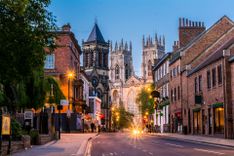The Garlic Farm
Some four miles southeast of Newport, the Garlic Farm makes for a fun day out, with farm tours of Arreton Valley available by foot or tractor. If you want to take some of the good stuff back home with you, choose from garlic-infused ice cream, mayonnaise and even vodka.
Their on-site cafe and restaurant serve up garlic-infused dishes (no surprises there) – just remember a packet of chewing gum for wherever you’re going afterwards…
Dimbola Lodge
This museum was once the home of Victorian photographer Julia Margaret Cameron, whose subjects included the likes of Charles Darwin. Following a circular one-way route, take in the displays of her photography and equipment, as well as iconic photography and memorabilia from the Isle of Wight festivals.
With advance booking, hand sanitiser points and positioned next door to Tennyson Down, this is another way to sightsee from a social distance and embrace the fresh air afterwards. Don’t miss the Jimi Hendrix statue in the front garden, either.
Wildheart Animal Sanctuary
Situated at the northern end of the Esplanade, and built into the walls of a Victorian fort, the Wildheart Animal Sanctuary houses one of Britain’s largest collections of tigers, including some endangered species that are virtually extinct in the wild. It’s also home to panthers and other big cats, as well as some frisky lemurs, monkeys and reptiles.
Carisbrooke Castle
Just southwest of Newport lies one of the Isle of Wight’s greatest attractions, the hilltop fortress of Carisbrooke Castle. This austere Norman keeps the most famous visitor Charles I, who was detained here prior to his execution in London.
The museum at the centre of the castle shows off many relics from his incarceration, and there is also the Edwardian-style Princess Beatrice Garden, named after Queen Victoria’s youngest daughter. The castle’s other notable curiosity is the sixteenth-century well-house which features resident donkeys. Visitors can also walk around the well-preserved battlements, basking in the spectacular views over the island.

















